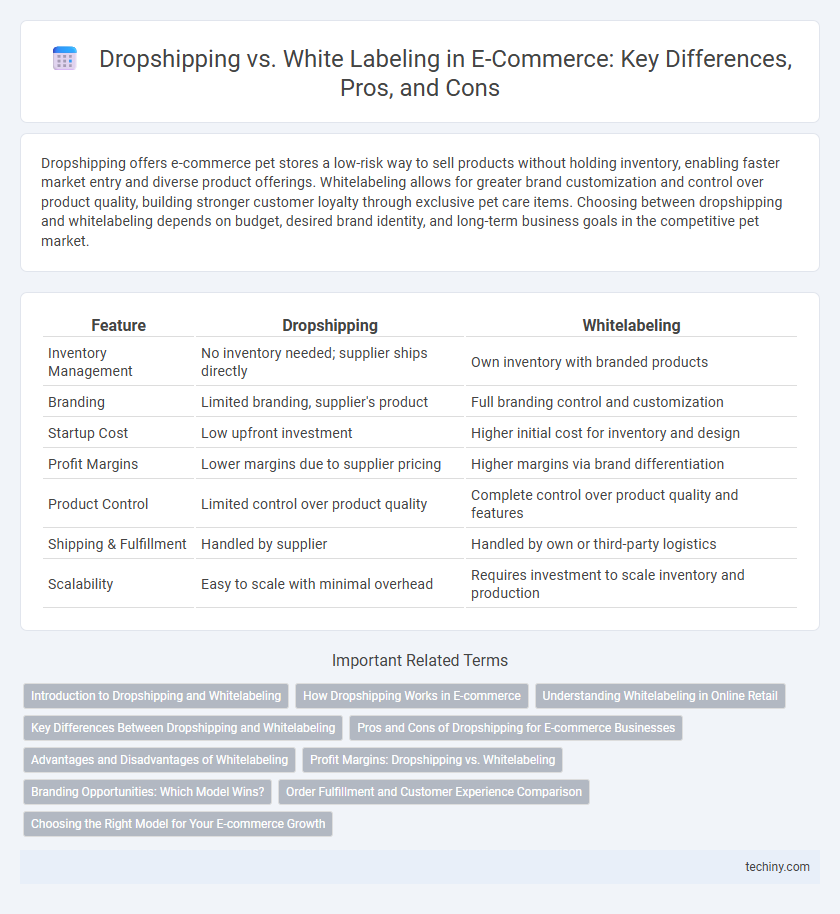Dropshipping offers e-commerce pet stores a low-risk way to sell products without holding inventory, enabling faster market entry and diverse product offerings. Whitelabeling allows for greater brand customization and control over product quality, building stronger customer loyalty through exclusive pet care items. Choosing between dropshipping and whitelabeling depends on budget, desired brand identity, and long-term business goals in the competitive pet market.
Table of Comparison
| Feature | Dropshipping | Whitelabeling |
|---|---|---|
| Inventory Management | No inventory needed; supplier ships directly | Own inventory with branded products |
| Branding | Limited branding, supplier's product | Full branding control and customization |
| Startup Cost | Low upfront investment | Higher initial cost for inventory and design |
| Profit Margins | Lower margins due to supplier pricing | Higher margins via brand differentiation |
| Product Control | Limited control over product quality | Complete control over product quality and features |
| Shipping & Fulfillment | Handled by supplier | Handled by own or third-party logistics |
| Scalability | Easy to scale with minimal overhead | Requires investment to scale inventory and production |
Introduction to Dropshipping and Whitelabeling
Dropshipping allows e-commerce sellers to list products without holding inventory, as suppliers handle storage and shipping directly to customers, reducing upfront costs and risk. Whitelabeling involves rebranding and selling pre-made products under the retailer's own brand, offering more control over product quality and marketing. Both models cater to different business strategies, with dropshipping emphasizing low investment and flexibility, while whitelabeling focuses on brand identity and unique product offerings.
How Dropshipping Works in E-commerce
Dropshipping in e-commerce enables retailers to sell products without holding inventory by partnering with suppliers who fulfill orders directly to customers. Retailers list the supplier's products on their online store, and when a customer places an order, the supplier ships the item, reducing upfront investment and inventory risks. This model streamlines order fulfillment and allows e-commerce businesses to scale quickly with minimal operational overhead.
Understanding Whitelabeling in Online Retail
Whitelabeling in online retail involves selling products manufactured by a third party under your own brand name, allowing complete control over branding and customer experience. This model differs from dropshipping by requiring inventory purchase upfront, leading to higher profit margins due to brand differentiation and quality assurance. Understanding whitelabeling is essential for e-commerce entrepreneurs aiming to build long-term brand loyalty and product exclusivity.
Key Differences Between Dropshipping and Whitelabeling
Dropshipping involves selling products directly from a supplier without holding inventory, while whitelabeling requires purchasing products in bulk to brand and sell as your own. Dropshipping offers low startup costs and minimal risk, but lower profit margins and less control over product quality and shipping. Whitelabeling demands higher initial investment and inventory management but provides greater brand control, customization, and higher profit potential.
Pros and Cons of Dropshipping for E-commerce Businesses
Dropshipping offers e-commerce businesses low upfront investment and reduced inventory risk, allowing entrepreneurs to test products without holding stock. However, it can lead to lower profit margins, less control over shipping times, and potential supply chain inconsistencies that may impact customer satisfaction. Businesses must weigh ease of entry against challenges in quality control and brand differentiation when choosing dropshipping.
Advantages and Disadvantages of Whitelabeling
Whitelabeling in e-commerce offers the advantage of brand control and higher profit margins by allowing sellers to customize products with their own branding, creating a unique market presence. However, it requires upfront investment in product development and inventory management, which can increase financial risk compared to dropshipping. Limited flexibility in product variety and longer fulfillment times are potential disadvantages that impact scalability and customer satisfaction.
Profit Margins: Dropshipping vs. Whitelabeling
Dropshipping typically offers lower profit margins, ranging from 10% to 30%, due to third-party supplier fees and higher per-unit costs. Whitelabeling delivers higher profit margins, often between 40% and 60%, by enabling businesses to control product branding and manufacturing costs. E-commerce entrepreneurs prioritize whitelabeling for scalable profit growth despite higher upfront investments compared to the low-risk, low-margin dropshipping model.
Branding Opportunities: Which Model Wins?
Whitelabeling offers superior branding opportunities by allowing businesses to create and market products under their own brand name, fostering customer loyalty and long-term recognition. Dropshipping relies on third-party products with limited customization, which restricts brand differentiation and control over the customer experience. Therefore, whitelabeling is the preferred model for entrepreneurs aiming to build a strong, unique brand identity in e-commerce.
Order Fulfillment and Customer Experience Comparison
Dropshipping relies on third-party suppliers to handle order fulfillment, enabling faster inventory scaling but often resulting in longer shipping times and less control over product quality, which can impact customer satisfaction. Whitelabeling involves sourcing and branding products directly, allowing businesses to oversee fulfillment processes, ensuring consistent packaging and faster shipping, thereby enhancing the overall customer experience. E-commerce entrepreneurs must weigh the trade-offs between dropshipping's low upfront costs and whitelabeling's greater control to optimize delivery speed and customer loyalty.
Choosing the Right Model for Your E-commerce Growth
Dropshipping offers low upfront costs and minimal inventory management, making it ideal for testing products and scaling quickly, while whitelabeling provides greater control over branding and product quality, enhancing customer loyalty and long-term margins. Selecting the right model depends on your business goals, with dropshipping favoring fast entry and flexibility, and whitelabeling supporting brand differentiation and higher profitability. Understanding factors such as budget, target market, and supply chain capabilities is essential for optimizing your e-commerce growth strategy.
Dropshipping vs Whitelabeling Infographic

 techiny.com
techiny.com